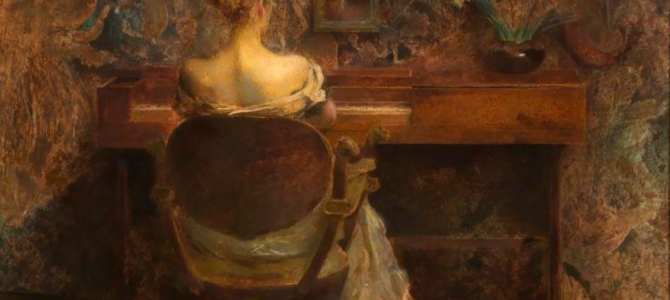
A gem of a show now at the Freer Gallery, part of the Smithsonian’s National Museum of Asian Art in Washington DC, offers a selection of works from the museum’s permanent collection by American painter Thomas Wilmer Dewing (1851-1938), many of which are rarely on display. While Dewing is the focus of the show, a significant part of its appeal is the opportunity to see many of the original frames that hold these paintings, pastels, and drawings, which were designed by Dewing’s friend, and one of America’s most famous architects, Stanford White (1853-1906).
Although all of the Smithsonian museums are currently shuttered due to the coronavirus outbreak, when they do reopen visitors to the Freer will be able to see how two great creative geniuses from America’s Gilded Age worked together. The Smithsonian has put the collection online. The effort between the two friends created works that are not only aesthetically pleasing, but also provide us an opportunity to see how, in art as in life, presentation is just as important to overall success as is content.
The Life of Thomas Dewing
Dewing was born in Boston, and began his artistic career working as an apprentice to a printmaker. In his 20s he moved to Paris for several years, studying at the famous Académie Julian, an institution that produced classically trained, forward-looking artists such as Félix Vallotton (1865-1925), whose retrospective at The Met The Federalist recently reviewed.
Absorbing the influences of the Barbizon school and the Aesthetic movement, Dewing developed a kind of dreamy, wistful style, which he put to particularly effective use in images of women, whether portrayed in sparsely furnished interiors or outdoors in misty, often undefined countryside settings.

After his return to America, Dewing eventually settled in New York, where he met and married fellow artist Maria Oakley Dewing (1845-1927), whose many connections in the New York art scene and social world of the time quickly helped him establish himself as one of the most in-demand artists of the day. The couple spent the summers in an art colony located in Cornish, New Hampshire, mingling with prominent artists, performers, and politicians, from Isadora Duncan to Frederic Remington to Woodrow Wilson, among many others.
Perhaps because Dewing’s distinctively ethereal images seem very much of their time, he isn’t as well known today as he once was. During his heyday Dewing was very much a society painter, in that his figures are usually elegantly dressed and languidly posed, and he often incorporated allegorical, intellectual, or poetic themes that would have appealed primarily to a more sophisticated audience. His work is usually softly executed, with no harsh colors or jarring elements, and few artists could paint a woman’s bare back more beautifully yet demurely.
Because of the more highbrow qualities in his work, Dewing’s patrons were often of very high social status, and as a result he occasionally received some rather extraordinary commissions. For example, in 1903 Steinway presented a grand piano to Teddy Roosevelt for the nation, commissioning Dewing to paint the lid with an allegory of America receiving the muses.

This arose partly out of Dewing’s popularity and connections, but also out of the fact that he loved to portray musical instruments of all kinds in his work, from pianos and spinets to mandolins, violas, and harps. Even more exotic-looking stringed instruments from North Africa appear in his paintings. The Dewing Steinway served as the main piano in the East Room of the White House for many years, and can now be seen a few blocks away, on loan to the American Art Museum.
Display Artistry By Stanford White
While the exhibition does an excellent job in demonstrating Dewing’s appeal, as an artist who was clearly very much aware of the aesthetics of his time, the show also makes the effort to show how many of the pieces on display appear as they do thanks to Dewing’s personal connection with one of America’s greatest architects.
Stanford White was a partner in McKim, Mead, and White, arguably the most important architectural design firm in America at the turn of the previous century. Among other structures, White designed the landmark Washington Square Arch in Greenwich Village, numerous mansions and private clubs, and oversaw the rebuilding of Thomas Jefferson’s famous Rotunda building at the University of Virginia after it nearly burned down.

White was friendly with a number of prominent artists and designers, including Louis Comfort Tiffany and Augustus Saint-Gaudens (another of the Cornish Art Colony gang), and among his many friends were the Dewings. As a result of their many years of friendship and professional collaboration, most of the Dewing works in the Freer exhibition are displayed in frames that White designed.

 For the visitor who has at least a passing familiarity with the Beaux-Arts aesthetic of a revived, monumental Classicism, and White’s importance in championing that movement in America, the lack of clean, classical design elements in most of the frames White designed is very surprising. Where we might expect to see things such as dentil moldings or reeded pilasters, we instead find surfaces covered with incredibly intricate, almost Islamic floral patterns, or thousands of tiny overlapping half-circles that look like fish scales, or repeating interwoven loops that combine to give the effect of a woven basket.
For the visitor who has at least a passing familiarity with the Beaux-Arts aesthetic of a revived, monumental Classicism, and White’s importance in championing that movement in America, the lack of clean, classical design elements in most of the frames White designed is very surprising. Where we might expect to see things such as dentil moldings or reeded pilasters, we instead find surfaces covered with incredibly intricate, almost Islamic floral patterns, or thousands of tiny overlapping half-circles that look like fish scales, or repeating interwoven loops that combine to give the effect of a woven basket.
Symbiotic Friendship and Framing
A fruitful and interesting discussion could be held, in front of each of the Dewing works with a White frame in this exhibition, as to why the architect felt that this particular frame was right for that particular painting, since no two of the frames in the exhibition are exactly alike.
“The friendship and support of architect Stanford White was critical to Dewing’s success,” notes one of the displays in the exhibition. The two were such good friends that they referred to each other in their letters by their nicknames of “Tommy” and “Stanny,” which was unconventional in that more formal era of correspondence.
White, who was building homes for some of America’s wealthiest people, such as the Astors and the Vanderbilts, recommended Dewing’s paintings to his clients as part of his overall interior design plan. The paintings were mounted in the elaborately carved, gilded frames White designed, to match the sumptuous interiors he designed for his Fifth Avenue and Newport patrons. They expected something more customized than just a standard, off-the-rack bit of coving framing their art, and White made sure that they got it.

This fruitful symbiosis between Dewing and White lasted for more than a dozen years. Then in 1906, White was murdered by the husband of one of his ex-mistresses, leading to what became known long before the O.J. Simpson case as the “Trial of the Century,” thanks in no small measure to left-wing gutter press publishers such as William Randolph Hearst. The murderer was eventually acquitted due to insanity, but the damage to White’s reputation was done, and many who were close to him were unfairly tarred if they dared to speak out in his defense.
Professional Effects of White’s Death
White’s death affected Dewing both personally and professionally, since the artist lost not only a good friend but also a major source of clients. Yet in touring the exhibition one also gets the sense that the loss also affected the presentation of Dewing’s work. One can immediately guess, even from across the room, which of the works in the show were framed by White, and which are displayed in off-the-shelf designs, whether from a period before the artist and the architect knew each other, or from after White’s murder.
It’s not to say that Dewing’s pictures are any less beautiful if they happen to be in a somewhat ordinary frame—far from it. That being said, the more standard frames don’t enhance the aesthetic appeal of Dewing’s art in the way that the White-designed frames unquestionably do.

Artists have always recognized the importance of proper framing as part of the presentation of a work of art, which is why Dewing and White were able to work together to create art objects that were fully realized as combinations of high art and decorative art. Yet it’s only within the last few decades that both museums and galleries have become more aware of their importance.
Recently, for example, as part of its exhibition marking the 500th anniversary of the death of Leonardo da Vinci (1452-1519), the National Gallery in London recreated the original setting for their version of his “Virgin of the Rocks” (c. 1508 and later). Seeing the painting as it was intended to be seen, not as an isolated canvas on a wall but framed as part of a larger, defined architectural space, fundamentally alters the way one understands the image.
What’s more, an increasing number of collectors are looking at frames as design objects worth collecting, even when they have been separated from the works of art which they were originally created to enhance. Later this month for example, a New York auction house will be selling a collection of frames by Eli Wilner and Co., among the most prestigious makers of hand-carved frames in America, whose clients have included the Metropolitan Museum of Art and the White House, among others.
Much More to Learn about Both Artists
As pleasing as the Freer exhibition is, it leaves the visitor with a number of unanswered questions. It’s tempting to think that Dewing may have been something of a one-trick-pony, simply creating portraits or landscapes with beautiful women doing very little, and he doing little of anything else.
A little research however, reveals that Dewing was also a brilliant draughtsman, who captured images of everyday life, family and friends, and landscapes with a kind of dark, heavy confidence in his line that is almost the polar-opposite of the soft images he executed on canvas. Similarly, while White’s work as an architect is very well known, what hasn’t been thoroughly explored, to my knowledge, is how he worked with his artist friends like Dewing to create works of art for the private homes and semi-private social spaces of American high society.

Perhaps a future exhibition will delve more thoroughly into a proper retrospective of Dewing’s work, from his Parisian student days through the end of his career, while another could bring together the wealth of painting, sculpture, and decorative objects White asked his friends to create for the spaces he built at the beginning of the American Century.
In the meantime, this more intimate Smithsonian show provides us some food for thought on the importance of making a good appearance, and of course a glimpse into what such large-scale, future exhibitions might look like. Although visitors will have to wait until the all-clear to see it in person, “Dewing’s Poetic World” is scheduled to be on display at the Smithsonian’s National Museum of Asian Art through November 2020.








